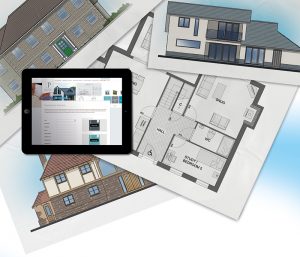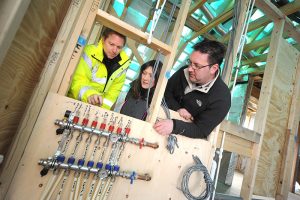Self Build for Service Leavers – Why it’s a Fabulous Proposition
Questions & Answers – Easy Resettlement Magazine

Prior to Self Build Specialist Potton’s complimentary ‘Insight into Self Building Day’ on 22nd July, Easy Resettlement Magazine asked Paul Newman, Self Build Director to demystify ‘self build’ and highlight how building your own home could be a viable option for Service Leavers.
From utilising the technical and project management skills you’ve gained over your years of service, to investing your Service gratuities and tax free pension lump sums in order to provide a new home for you and your family, self building may well be the first step, in the next chapter of your life!
So, what is self-build?
Well it’s perhaps not as obvious as you might at first think. We’ve probably all enjoyed the plethora of TV shows that spotlight building your own home but in reality, these popular TV programmes bear little resemblance to the experience of most self builders.
For starters, the term itself is largely a misnomer, most self builders are more aptly described as ‘families who commission and participate in the design and construction of their new home’. The problem with this is that whilst it is more descriptive it hardly trips off the tongue. So, Self Build it is.
Most of Potton’s customers commission us to work with them to design their new home, taking into consideration the constraints and opportunities offered by the plot they have found and now proudly own. We make the planning application for them and then provide a package of services and products including the building structure, doors, windows and insulation. Only a very small percentage of self builders take on the bulk of the build themselves. Approximately 40% manage the build themselves, tendering and employing the various sub contract trades, 40% employ a professional Project Manager and the balance contract with a Builder to deliver a turnkey service.
Why bother?
It’s really hard to capture, in simple terms, the factors that motivate people to Self Build are as diverse as our population. Many are frustrated by the limitations present in what they can purchase from House Builders or Estate Agents. Others take on the challenge to make or save money, some are motivated by design and a desire to create something that genuinely works for the way their family lives – now and in the future.
Increasingly, those self builders have a desire to build something that is significantly more energy efficient than our Building Regulations require. For most, the driving factor is to be involved in designing and constructing a home, that meets the needs of their family and is of a significantly higher specification and performance than the mainstream market can hope to offer. If you want something, that meets your needs rather than those of a developer, something that will put a real dent in your fuel bills or generate profit when it is sold, then Self Build is probably for you.

How do you find land to build on?
This is probably the hardest part of building your own home. There are a number of routes you can take but you will probably need to do them all… and mostly at the same time.
The key is to be organised, focussed, tenacious and determined and not to lose heart! Make sure you’re clear on your requirements and on what you are and aren’t prepared to compromise on – being prepared to compromise will help you find a plot.
Crucially, and this really is great news, recent changes in legislation have introduced something known as the ‘Right to Build’. In essence, the legislation means that, Local Authorities now have to keep a register of people who wish to self build in their area and they then have 3 years to ‘satisfy the demand indicated by the register’ with plots for self build that have planning permission. So, make sure you register with your Local Authority and keep in touch with them to find out what they are doing to bring forward plots and sites.
Things to do:
- Subscribe to the plot listing services on the web – Plot Browser, Plot Finder, Plot Search for example are all great but don’t forget that everyone else will be on them as well.
- Network, network, network – sell yourself and your family – I’m sure we can all think of great USPs for our own families, and become a self build bore (hopefully only a temporary step). Make sure everyone you know understands you are serious about looking for a plot to build on. Treat the exercise as a marketing project and go as far as handing out flyers to friends, family and colleagues. Make sure you don’t forget local pubs and shops.
- Register your interest with estate agents and particularly with local land agents – remind them regularly that you’re still interested and be very clear about what you’re looking for.
- Use online mapping services to try and identify vacant plots and walk or drive slowly around the areas you are interested in. Buy a large scale OS Map of the area you are interested in. Focus on individual map squares and once you are sure you have checked one out thoroughly move on to the next location. Having a larger search area is not always helpful, particularly if you approach things in a scattergun manner.
- Check the planning section of the Local Authority website on a Friday afternoon for new applications, those that have been approved and those that have been rejected. Some people seek permission to develop simply to increase the value of their land and in order to facilitate sale. Note that a rejection might only mean that the application was poor or the house design unsuitable for the plot. You can use the information available on the website to approach the landowner or their agents. Approaching people in this way probably won’t bag you a cheaper plot but it may well get you to the head of the queue.
- Look for opportunities to purchase tired, empty or derelict properties with a view to knocking them down and rebuilding something that meets the needs of your family. As an alternative to constructing a Replacement Dwelling why not look for plots with large and appropriately located gardens for an old fashioned Garden Grab!
- Look out for building sites that have ‘stalled’. Whilst it may feel like ambulance chasing by offering to the plot you are probably helping out someone who’s run out of money.
How can I get started?
The Self Build Academy provides an evolving range of events, seminars, workshops, courses and networking that aim to equip self builders with the knowledge they need at every stage of their journey. The academy covers everything from finding a plot through to finishing off the build. It will instruct you on how to develop a design brief, establish and articulate your views on energy efficiency, provide opportunities to visit sites during construction and teach you how to build safely and efficiently.

STEVE HODGKIN / Credit – CHADWICKS –
Can self builders obtain a mortgage
Yes, there is an established market for Self Build mortgages with funding released at key stages during construction, rather than all at once on completion day. Currently, the lenders involved in the sector tend to be smaller Building Societies but several larger lenders are rumoured to be eyeing up the market and a few have already entered it.
Some lenders will lend on the land purchase or existing property and at key stages during and on completion of the build project. Others do not lend on land, but they will lend during the build period. Typically, lenders will provide:
- 75-90% of the purchase price or valuation (whichever of the two is the lower)
- up to 80-90% of build costs
- up to 75% of the growth in value of your project at key stages during construction
The range of products available mirror the more normal market and include, discount rate, fixed rate, tracker and offset mortgages. Rates of interest are slightly higher than standard house purchase/re-mortgage rates and inevitably arrangement fees vary from lender to lender as do tie in periods. Once your new home is properly habitable it may be possible to switch to a lower rate of interest. Release stages vary from lender to lender but may be:
- Land (with the minimum of outline planning consent)
- Substructure
- Wallplate/eaves height (just before the roof structure goes on)
- Wind and watertight roof tiled
- First fix
- Second fix
- Certified completion
Your lender will want details of build costs and will need to be convinced that you are sufficiently competent to complete your new home.
How much does it cost?
It all starts with the budget, and indeed ends with the budget as well. Budgeting is not something that you think of once and then forget. It is an on-going process and something that has to be honed and refined throughout the project.
The first and, perhaps, the biggest expenditure is going to be the plot. In some areas, where house prices are low, that may be around a quarter of the eventual value of your home. In high priced areas, it may be two thirds or more of the end value. There is a simple formula for valuing land, which works in most cases and can be checked using prices from websites like Zoopla or Rightmove. Don’t forget that you will need to factor in an allowance for conveyancing or forget that services have to be connected. Also, remember that you need to live somewhere during the course of the build.
Land costs + Build Costs x Margin (%) = End value
As we’ve explained above, land costs vary hugely across the country. Thankfully, material and labour costs are much more consistent though there are still regional variations, particularly for labour costs. This is because if your plot is in an expensive area then it is likely that the construction trades working on the build are also having to live and pay their mortgages and rents in that same area.
As a general guide, it’s reasonable to assume that in most parts of the UK it will be possible to build for around £1400m2 if you manage the build yourself. In less expensive areas this cost will come down, in more expensive ones it will go up.
If you decide to employ a project manager or use a builder then your costs will go up by maybe 8% – 15%. Clearly, it is also possible to save money by taking on some of the work yourself and spend more by increasing the specification of the build. It is easier to increase cost per metre than it is to reduce it but both are possible. If you keep reducing material costs then at some point it will start to show in the quality of your finished home. The flip side of this is that there is always a more expensive way of building something. Everything from bricks, roof tiles, kitchens and bathrooms to media systems, floor finishes and wall paper are available at an incredibly wide range of prices. Ultimately, you need to create a budget specific to your build and you can’t do this properly until you have a design to price against and a level of specification and list of priorities clearly identified.
How Can I Get Started?
The Self Build Academy provides an evolving range of events, seminars, workshops, courses and networking sessions (think coffee morning rather business breakfast) that aim to equip self builders with the knowledge they need at every stage of their journey. The academy covers everything from finding a plot through to finishing off the build. It will instruct you on how to develop a design brief, establish and articulate your views on energy efficiency, provide opportunities to visit sites during construction and teach you how to build safely and efficiently.
SERVICE LEAVERS AND VETERANS SELF BUILD EVENT
Potton is hosting a free one-day event (to include lunch) on 22nd July 2017, for Service Leavers and Veterans interested in finding out more about self building.
To register for the event, please visit
www.potton.co.uk/service-leavers
Details will then be emailed to you directly.


Comments are closed, but trackbacks and pingbacks are open.